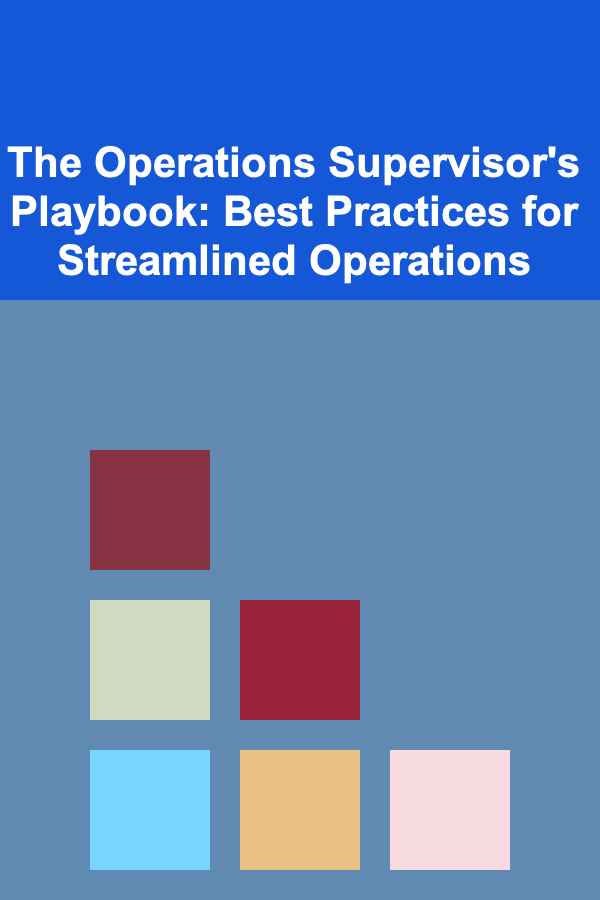
The Operations Supervisor's Playbook: Best Practices for Streamlined Operations
ebook include PDF & Audio bundle (Micro Guide)
$12.99$7.99
Limited Time Offer! Order within the next:

In any organization, the Operations Supervisor plays a critical role in ensuring smooth, efficient, and productive workflows. While they don't typically make the strategic decisions, their day-to-day oversight directly impacts the company's ability to execute its strategy effectively. Streamlining operations isn't just about cutting costs or eliminating inefficiencies; it's about creating an environment where people, processes, and resources work together seamlessly to deliver consistent results. This playbook provides actionable best practices for Operations Supervisors looking to optimize their workflows, boost team performance, and deliver on organizational goals.
Understanding the Role of the Operations Supervisor
Before diving into best practices, it's important to understand the scope of an Operations Supervisor's responsibilities. This role typically involves:
- Managing Resources: Ensuring that human, financial, and physical resources are effectively allocated.
- Overseeing Daily Operations: Monitoring workflows and making adjustments to ensure that tasks are completed efficiently and on time.
- Problem-Solving: Addressing issues that arise in real time and finding solutions to keep operations running smoothly.
- Driving Continuous Improvement: Identifying inefficiencies and implementing changes to improve overall performance.
The goal of the Operations Supervisor is to ensure that the day-to-day functions of the organization align with larger company goals, while continuously looking for opportunities to streamline and enhance operations.
Establish a Clear Vision and Set SMART Goals
The first step in streamlining operations is establishing a clear, actionable vision. Without direction, efforts to improve efficiency will lack focus and may fail. As an Operations Supervisor, you must define clear, achievable goals that align with broader organizational objectives.
Best Practice:
- Set SMART Goals: Goals should be Specific, Measurable, Achievable, Relevant, and Time-bound. For example, a SMART goal could be: "Increase production output by 15% in the next quarter without sacrificing quality."
By setting SMART goals, you provide clarity and ensure that your team understands what success looks like. These goals become the foundation for all operational strategies and allow for consistent progress measurement.
Map and Analyze Current Workflows
Efficient workflows are the cornerstone of operational success. However, before improvements can be made, you need a comprehensive understanding of how work currently flows within the organization. Mapping existing workflows helps identify inefficiencies, redundancies, and bottlenecks that need to be addressed.
Best Practice:
- Conduct a Workflow Audit: Regularly analyze and map out your processes. Tools like flowcharts or business process mapping software can help visualize current workflows. Look for areas where tasks are delayed or where resources are underutilized.
- Engage the Team: Often, the people who perform the tasks are best positioned to identify where improvements can be made. Encourage feedback from team members to get insights into inefficiencies that may not be immediately obvious.
This analysis not only helps you pinpoint areas for improvement but also gives you a clearer understanding of what's working and what isn't.
Automate Repetitive and Time-Consuming Tasks
In today's digital world, automation is a powerful tool for streamlining operations. By automating repetitive tasks, you free up valuable human resources for more strategic, value-added activities. Automation helps reduce human error, increase speed, and ensure consistency in execution.
Best Practice:
- Identify Tasks for Automation: Look for repetitive tasks such as data entry, reporting, or inventory management that could be automated using software. For example, automated invoicing or scheduling systems can significantly reduce manual work.
- Leverage Project Management Tools : Use tools like Asana, Monday.com, or Trello to automate task assignments, reminders, and progress tracking. These tools can help you manage projects more efficiently by centralizing communication and streamlining the task flow.
Automating tasks not only speeds up operations but also ensures that employees focus on higher-level work that requires creativity and problem-solving skills.
Optimize Resource Allocation
Efficient resource allocation is essential for ensuring that operations run smoothly. Overstaffing, understaffing, or misallocating resources can result in wasted time, missed deadlines, and diminished productivity.
Best Practice:
- Assess Resource Needs: Regularly evaluate whether your team has the right number of people, skills, and equipment to meet operational demands. Understand peak times or busy seasons, and adjust staffing levels accordingly.
- Monitor Resource Utilization: Use data and analytics tools to monitor how resources are being used across different tasks. This can help identify underutilized assets or employees who are stretched too thin.
Effective resource allocation ensures that everyone on your team is operating at full capacity without being overwhelmed or underworked.
Streamline Communication
Effective communication is key to maintaining a smooth workflow. Inefficient or unclear communication can cause delays, misunderstandings, and mistakes that hinder productivity. As an Operations Supervisor, you must establish clear communication practices to avoid these pitfalls.
Best Practice:
- Centralize Communication: Use communication platforms like Slack, Microsoft Teams, or Zoom to centralize team conversations and eliminate the need for back-and-forth emails. This ensures that everyone is on the same page in real-time.
- Set Expectations for Communication: Establish guidelines for communication, such as expected response times, preferred methods for different types of messages, and when to escalate issues to a supervisor or manager.
A streamlined communication process ensures that important information flows quickly and clearly throughout the team, reducing delays and confusion.
Foster a Culture of Continuous Improvement
Efficiency is not a one-time achievement; it's an ongoing process. As an Operations Supervisor, you must cultivate a culture where continuous improvement is encouraged and embraced. This mindset helps identify opportunities for refinement and prevents complacency from creeping into the workflow.
Best Practice:
- Encourage Employee Feedback: Continuously solicit feedback from your team about how operations can be improved. Create a safe space where employees feel comfortable sharing their thoughts on inefficiencies or roadblocks they experience.
- Implement Lean Principles: Adopt Lean methodologies to eliminate waste, improve workflows, and ensure that every process adds value to the organization. Regularly review operations to remove non-value-adding activities.
- Measure Performance: Use Key Performance Indicators (KPIs) to track your progress. Metrics like task completion time, quality standards, or customer satisfaction can provide insight into where you're succeeding and where adjustments need to be made.
By fostering a culture of continuous improvement, you create an environment where efficiency becomes ingrained in every aspect of the operation.
Implement Real-Time Monitoring and Adjustments
Even the best-laid plans need to be monitored in real-time to ensure they're being executed correctly. Operations Supervisors need to stay on top of daily activities and be ready to make adjustments when issues arise. This ability to respond quickly is crucial for minimizing downtime and keeping operations running smoothly.
Best Practice:
- Use Real-Time Analytics: Leverage software tools that provide real-time data on task completion, resource usage, and other key metrics. Tools like Tableau or Google Analytics can provide dashboards that offer insights into how workflows are progressing.
- Establish a Feedback Loop: Create a system where team members can quickly report issues or changes that affect workflow. Real-time feedback allows you to adjust the operations as needed, minimizing disruptions and maximizing efficiency.
Real-time monitoring and responsiveness ensure that operations stay on track, even when unexpected issues arise.
Promote Accountability and Team Empowerment
An effective Operations Supervisor knows that the success of a team is not just about managing processes but also about managing people. Ensuring that team members are accountable for their roles and empowered to make decisions helps to keep workflows running smoothly.
Best Practice:
- Clearly Define Roles and Responsibilities: Make sure each team member understands their specific role in the workflow and how it contributes to the overall success of the operation. This clarity fosters a sense of ownership and responsibility.
- Provide Training and Development: Offer regular training to enhance the skills of your team members. This will not only increase their efficiency but also make them more confident in their ability to execute tasks independently.
- Recognize and Reward Success: Celebrate achievements and improvements, both big and small. Recognizing the efforts of your team helps boost morale and motivates employees to continue improving.
A team that is both accountable and empowered will be more motivated, engaged, and committed to achieving operational excellence.
Conclusion
The role of an Operations Supervisor is crucial in driving efficiency and ensuring that workflows align with organizational goals. By implementing these best practices---setting clear goals, automating repetitive tasks, optimizing resource allocation, streamlining communication, fostering continuous improvement, and empowering your team---you can create a well-oiled machine that delivers results consistently. Ultimately, the key to streamlined operations lies in understanding the intricacies of both your processes and your team, and making the necessary adjustments to keep things running at peak performance. By doing so, you'll not only improve operational efficiency but also contribute to the long-term success of your organization.

How to Cook for a Healthy Gut
Read More
How to Get Started with Cryptocurrency Investments
Read More
How to Keep Your Kitchen Towels Neat and Accessible
Read More
How to Prevent Noise From Neighbors in Shared Walls
Read More
How to Set Up a Pet Care Budget for Expenses and Emergencies
Read More
How to Shop for Furniture on a Budget Without Compromising Style
Read MoreOther Products

How to Cook for a Healthy Gut
Read More
How to Get Started with Cryptocurrency Investments
Read More
How to Keep Your Kitchen Towels Neat and Accessible
Read More
How to Prevent Noise From Neighbors in Shared Walls
Read More
How to Set Up a Pet Care Budget for Expenses and Emergencies
Read More